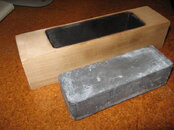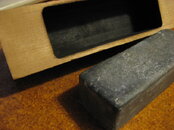shogan
Contributor
1. Lead is getting tough to get for free it helps to be a regular patron of donors.
2. Wheel weights are becoming increasingly not lead.
3. Wheel weights have a whole lot of garbage and your going to spend fair amount of time dealing with that garbage i.e. little metal fasteners.
4. Melting lead is messy and you should do it on turkey fryer out in the yard not on the patio.
5. Have a good work station ready, you need a metal sloted spatula or the like to remove non lead items from melting pot.
6. Pot holders are good.
7. Towel wrapped around your face is good.
8. Set up melting operation so the wind is blowing away from you while working.
9. Sardine cans make a nice reusable mold, Tuna cans are a decent disposable mold, the bottom quater of a soda can (long ways) makes a nice disposable mold are readily abundant, but may not fit many of the smaller pouches.
10. Lead weights may be hot for a while don't touch them or you will get burned.
Total invested, time about 4 hours, . Donated to cause 2 pans that were on the to be thrown out list, 1 spatula, 1 can of sardines purchased and consumed, 4 soda's consumed, and I'm eating Tuna Sandwhiches for lunch. Tin Foil to put the slag and crud on.
Total Gained Roughly 30 lbs of hard weight, some prettier and smoother than others. The weights range from 1-4lbs roughly.
Glad I did it but don't see myself doing it again with wheel weights.
2. Wheel weights are becoming increasingly not lead.
3. Wheel weights have a whole lot of garbage and your going to spend fair amount of time dealing with that garbage i.e. little metal fasteners.
4. Melting lead is messy and you should do it on turkey fryer out in the yard not on the patio.
5. Have a good work station ready, you need a metal sloted spatula or the like to remove non lead items from melting pot.
6. Pot holders are good.
7. Towel wrapped around your face is good.
8. Set up melting operation so the wind is blowing away from you while working.
9. Sardine cans make a nice reusable mold, Tuna cans are a decent disposable mold, the bottom quater of a soda can (long ways) makes a nice disposable mold are readily abundant, but may not fit many of the smaller pouches.
10. Lead weights may be hot for a while don't touch them or you will get burned.

Total invested, time about 4 hours, . Donated to cause 2 pans that were on the to be thrown out list, 1 spatula, 1 can of sardines purchased and consumed, 4 soda's consumed, and I'm eating Tuna Sandwhiches for lunch. Tin Foil to put the slag and crud on.
Total Gained Roughly 30 lbs of hard weight, some prettier and smoother than others. The weights range from 1-4lbs roughly.
Glad I did it but don't see myself doing it again with wheel weights.














